|
|
|
The
Prow, Cathedral Ledge, New Hampshire By:
Scott Ghiz |
|
Early October 1998. A Saturday afternoon. College
football games fill the TV time on the weekends and yard chores
fill the rest of the void.
My climbing activities have been filled with working for a
start-up company, trying to sell software that really didn't
exist. Also, my two-and-a-half-year-old daughter was
taking up much of my free periods, not that I minded that at
all. My wife was five months pregnant with daughter number
two. I guess a good weather report for New Hampshire, a
lack of climbing and too much BS at work got me thinking about
rope-soloing the Prow on Cathedral Ledge in New Hampshire.
I asked the boss (read: wife) if it would be OK for me to go
climbing. I got the thumbs up and began the task of
sorting out all of the aid gear for this little
adventure.
|
|
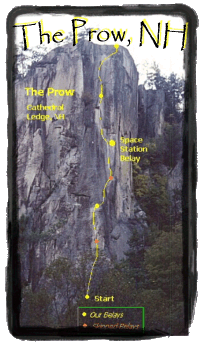
|
|
The
Prow, Cathedral Ledge. We found it to be III
5.7 C1+. The
yellow dots are where we belayed. The orange dots
are where the standard belays are. |
|
|
| I knew my regular climbing partner, Mark,
was in a very similar situation. His first
daughter was born two weeks before my daughter.
His wife just found out that she was pregnant with their
second child and was due, June 1999. I gave him a
call to see if he could, would, join me on this
mini-trip. He also got the go-ahead after a little
muffled discussion.
The trip was on within ten minutes at 5:00 PM.
Fastest planned trip ever. Day trips to the Gunks
take longer to plan.
|
After gathering all of the gear, we had to stop by the garage
where Mark has work done on his 1987 VW Scirocco. He had
to pay for the work done on the car so he could pick it up on
the way back from NH on Sunday night. By the way, I live
in Eastern PA and Mark lives in Clinton NJ, seven to eight hours
away from Cathedral Ledge.
We drove all the way to the Kancamangus Highway, just a few
miles south North Conway, NH where Cathedral Ledge is. All
along the Kancamangus Highway are state campgrounds. We
found an empty site around 1:00 AM Sunday and tried to get a
little sleep.
We awoke after a few hours of broken sleep at around 5:30 AM
and drove into North Conway for coffee and doughnuts. It
was very cold out and we hunkered down in the coffee shop for a
little while waiting for the sun to filter into the Mt.
Washington Valley. We finally arrived below Cathedral
Ledge at 8:00 AM. It was still very cold, so we took our
time racking up for the day.
|
 |
|
Mark at
the start of the first pitch explaining the ascender
rental agreement. |
|
|
As we hiked to the start of the climb, I realized
I forgot my helmet. Back down to the car, get the key out
of the hiding spot, unlock car, get helmet, lock car, hide key,
hike back up. Once I got back up the talus slope, I
realized I forgot my ascenders. S%^T!!! I'm either: Getting old,
stupid, not enough coffee or not enough sleep. I bet it's
a combination of all four. Repeat process, except for when
I get to the 'retrieve ascenders' phase. I realize that I
left the ascenders hanging on the two pieces of 9mm cord in my
basement. S%^T!!! On the way up to meet Mark at the base,
I try to figure out a clever way to explain my ineptitude.
No way. Just plead guilty and get on with the climb.
Mark says he won't charge me too much to use his ascenders when
I have to follow his leads. Thanks pal. I won't make
you ride on the outside of my truck for the eight hour drive
home later ;) |
| We still had to negotiate the final 40 feet to the
start of the climb. Heck, between climbing over the rotten
trees or soloing up dirty slabs, I'm surprised we didn't give up
and go back to the coffee shop.
We started climbing around 9:00 AM and it was actually nice
and warm in the sunny, sheltered alcove at the base of the
route. I could have easily taken a nap.
Pitch 1 & 2:
Mark combined the first two pitches into a single long
pitch. The first section is 5.7 free climbing starting in
a wide crack and leading to a steep headwall. The headwall
is climbed on aid with fixed gear, small cams and nuts.
The aid is a little strenuous and awkward. The belay is at
a nice horizontal crack with a convenient stance. 155
feet, 5.7 C1+.
Mark gave the signal that he either had gas or my rope was
fixed. I got moving and regained some of the efficiency on
ascenders that I had known during the Yosemite days. I
guess it is like riding a bike.
I really liked Mark's ascenders. I think he uses
Petzl. I've always used CMI ascenders for their super
strength, but who cares when either model could hold 40 of
me? I couldn't let on that I thought his ascenders were
great. When he asked how the Petzl's worked out, all I
could muster was, "They basically stink like your
shoes."
We did the big-wall/aid change over. Drank some water
and got moving on the next pitch.
Pitch 3 & 4:
My lead. I linked the standard 'book' pitches 3 & 4
into one pitch, our second pitch overall. The pitch turns
the corner on the right on small cams and moves to the other
side of the Prow. It's a neat experience to move back and
forth around this big arete, just like some sport climbs, except
we're aiding most of this. The other side of the Prow was
shady and cold. While Mark was hanging out in the warm sun
(and probably sleeping) I was getting chilled on the far side of
the moon.
|
|

|
|
Mark on
the steep headwall of the linked first pitch. |
|
|
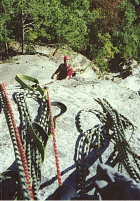
|
|
Me
using Mark's ascenders on the first pitch. |
|
|
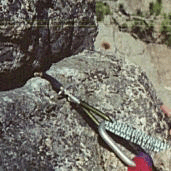
|
|
The
first piece of our second pitch on the Prow. |
|
|
| After moving around the corner, the pitch moves up a big and
somewhat loose flake. I used a hook and a sling over the
top of the flake to avoid flexing this chunk of granite. A
crack right on the edge of the Prow is reached and is followed
to the bolted belay at the end of pitch 3. Two bolts lead to a
long reach from the top bolt to place a small Camalot Jr in the
crack above (C1+). A beautiful finger crack leads
straight up towards the triangular roof on the next pitch. |
|
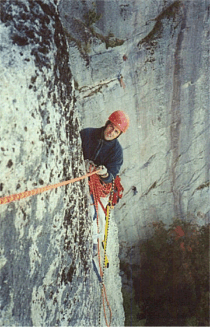
|
|
Me,
very cold, at the Space Station Belay. |
|
|
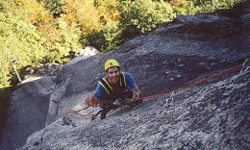
|
|
Mark
ascending the fixed line to the Space Station Belay. |
|
|
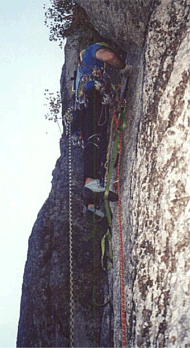
|
|
Mark
getting into the crux aid section, beginning the corner
leading to the triangular roof. |
|
|
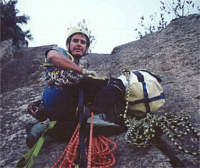
|
|
Mark, a
little hungry, at the hanging stance above the
triangular roof. |
|
|
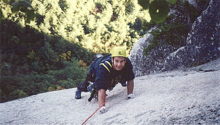
|
|
Mark
greasing off the slab near the top. |
|
|
| Before reaching the corner leading to the
triangular roof, I stepped off to the right and belayed at the
infamous Space Station Belay. The name was given to this
spot because of it's exposed position and the large plywood
platform Jim Surrete (sp?) used for his belaying station while
he worked out the extreme free moves on a 5.13 around the corner
from our route.
We didn't even have a belay seat, let alone a plywood
platform. I think a bosun's chair would have been nice.
The Space Station Belay was spectacular. It is
basically right on the nose of the Prow. You can see a ton
of climbers all over the Thin Air face. You can also see
the lines of climbers queuing up for Recompense, an ultra
classic 5.9 just to the left of the Prow route that we were on.
Pitch 5:
We did our typical gear exchange and I encouraged Mark to get
moving on the next pitch, the triangular roof pitch. I
believe this is regarded as the crux of the free version of the
Prow (5.11+). I'm pretty sure it was the aid crux based on
the pieces I cleaned. It looked like MC had to use
numerous small brass HB offsets up the corner leading to the
roof. I think we decided C1+ was about right, maybe even
C2. You didn't want to fall onto the small nuts and manky
pins leading off the Space Station Belay for 40 feet. Mark
did quite a nice job keeping it together while I cussed him out
for going so slow.
I really had to take a pee, but being at the Space Station
Belay is tantamount to being in the midst of the Stoveleg cracks
with a couple of tour busses worth of tourists eyeing you
through dozens of binoculars. I held it like a big boy.
Mark had a nice 5th Avenue candy bar stashed into the bottom
of the mini-haul bag. I ate it, but told him I dropped it
while digging for more film.
Mark reached the hanging belay stance just above
the triangular roof just before I reached phase two
hypothermia. He fixed the lead rope and hand hauled the
mini-pig. I then heard the mumbling, "Where the heck
is is that thing? I thought I put a 5th Avenue in
here..."
Pitch 6:
The final pitch, or so I thought. It starts off in a
nice thin finger crack at 5.9. But I was cold, tired and
my fingers were covered in chocolate. It was an easy C1
for 60 feet until I reached the slab. I free climbed
across the slab (5.6) to the base of the wide crack that leads
to the top. The crack is only about 15' long. We
brought a #3 Camalot as our token large piece. I plugged
this guy in low, made a move to the mantle into an alcove just
below the top. I could not do the move. It's only
rated 5.6 in the guidebook, But I tried everything to get up
this move. I just couldn't do it. I had to set up a
belay at the base of this crack and let Mr. Cool give it a shot. |
| I was pissed at myself for being such a
wimp. Mark came up and struggled across the slab. I
was thinking we would need to be rescued 15 feet from the
tourist railing. How embarrassing would that be? We
gathered our gear and Mark prepared for the final two moves of
the climb. I then realized that I couldn't do the mantle
because of my helmet. It hit the wall of the alcove just
before I could get my center of gravity over my hands while
doing the mantle. I thought about not telling MC this
revelation and letting him struggle, but I was hungry (not quite
as hungry as Mark), cold and getting tired. I gave him the
keys to the city and we were on top two minutes later. |
|
The Finish
We topped out at 3:30 PM after spending 6 and a half hours on
the climb. We were hoping for a ride down off the top via
the auto road. But the only people on top were a biker
(motorcycle) couple making out with each other, a large conservative looking
family piling into and out of their brand new mini-van and a
couple of bicyclists. We walked all the way down to my
truck. I finally took a whiz at the porta-potty and we hit
the road and a huge traffic jam in North Conway. Everyone
was in the Mt. Washington Valley checking out the fall foliage
and buying new shoes at the Bass outlet.
To make a long story short, we stopped for a lot of coffee
and jetted across the Kancamangus highway to route 93
south. I was falling asleep by the time we got back to NY
and I let Mark drive back to his mechanic's station to pick up
his car. I drove by myself from there, getting home around
1:00 AM Monday morning. A thirty two hour,
round trip adventure. |
The Gear
- 1.5 sets of brass nuts (HB offsets useful)
- 1.5 sets of small to medium wires
- 1 set large wires
- 1 #0.5 Tri-Cam
- 1 #1 Tri-Cam
- 1 each of the 4 smallest Aliens
- 1 each of the 4 smallest TCUs
- 1 each Friends to #3
- 1 each Camalots to #3
- Cam hooks
- Talon hooks
- 60m lead line
- 50m haul/tag line
I recommend doing the direct finish up the 5.10a or C1 thin
crack to the top. Much less awkward and it keeps the route
character consistent. That last 5.6 section is totally
different than the rest of the climb.
The Prow (III 5.7 C1+) is an outstanding day climb which is
very similar to the difficulties you would find on either the
Regular NW Face of Half Dome or The Nose on El Capitan, both in
Yosemite Valley.
|
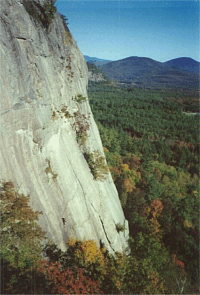
|
The
scenic view of the Thin Air face on Cathedral Ledge from
the top of the second 'book' pitch. |
|
|
|